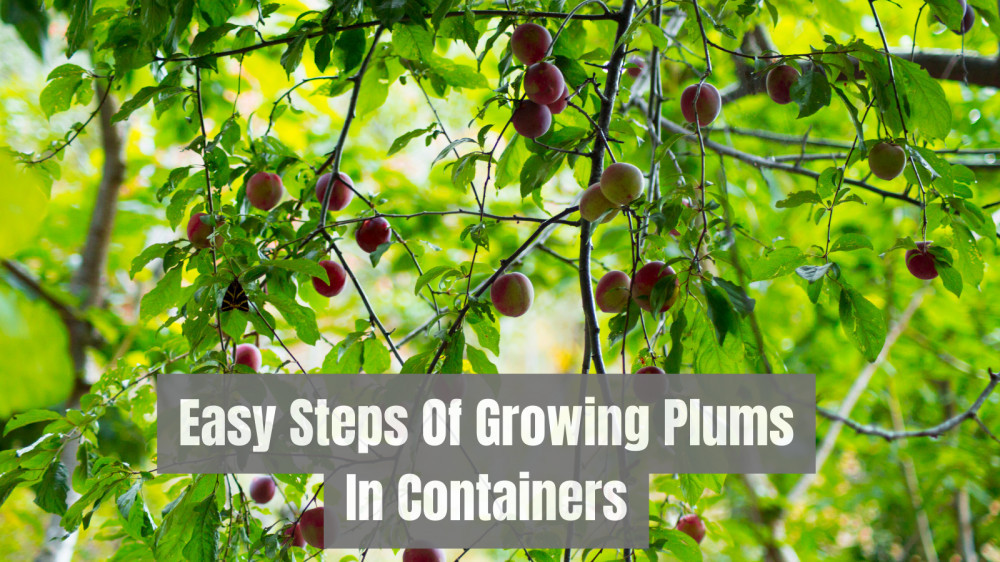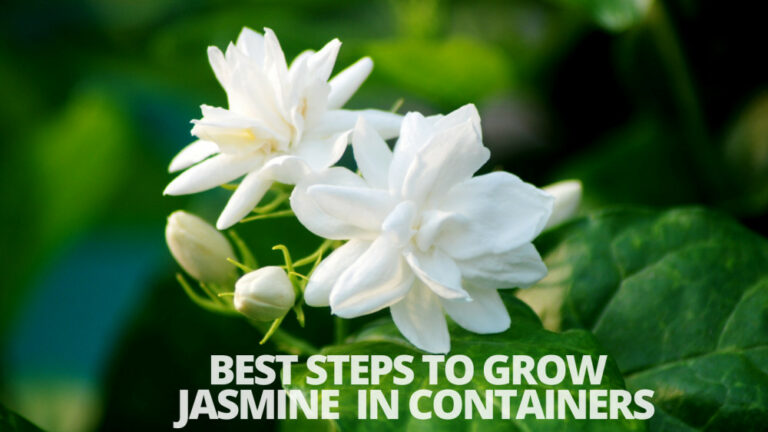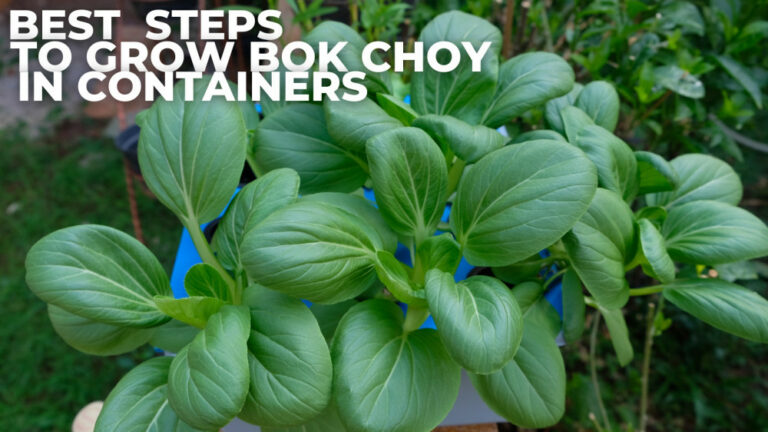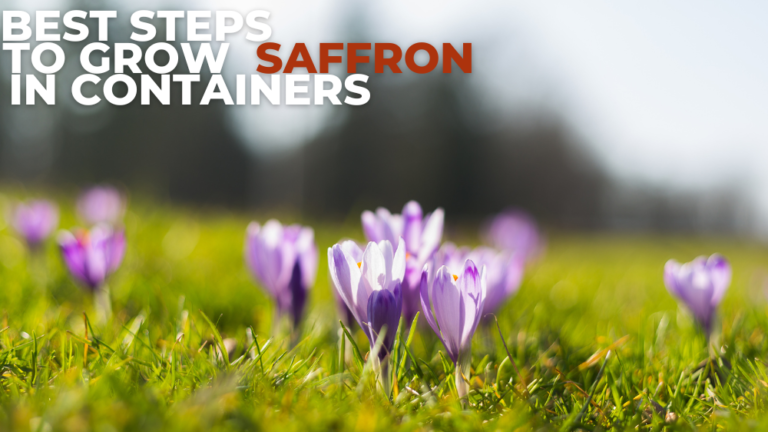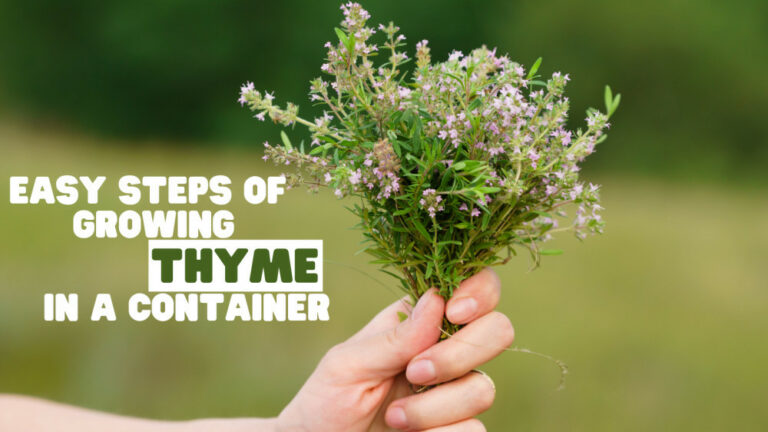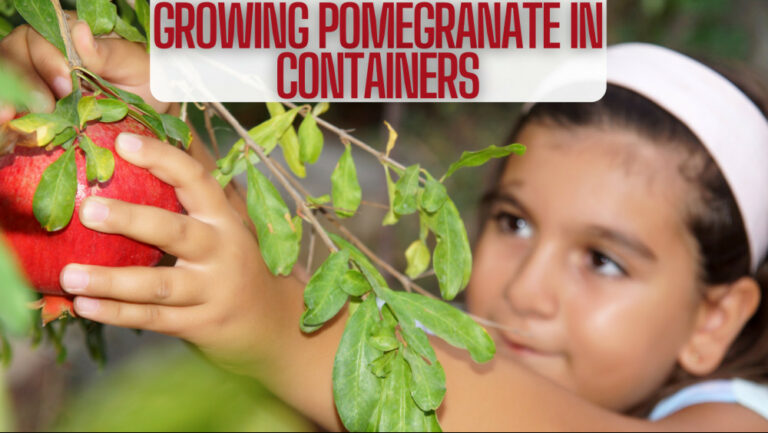Easy Steps Of Growing Plums In Containers
Easy Steps Of Growing Plums In Containers
Prunus Domestica, sometimes known as the common plum tree, is a hardy deciduous tree. Plum trees are planted for their decorative value and seasonal fruits.
They are one of the few fruit trees that can be planted in pots and reach a height of around 2 meters, making them simple to maintain.
Growing plum trees in pots are not difficult, but you should follow some basic guidelines. Hope the blog will help you with growing plums in containers.
Origin Of Plums
Plum and several Prunus trees or shrubs (family Rosaceae) bear excellent fruits. Plums, like peaches and cherries, are popular as a dessert fruit, cooked as a compote or jam, or baked in various pastries.
Commercially, the European plum (P. domestica) and Japanese plum (P. salicina) are produced for their fruits. However, certain species, such as the purple-leaf plum (P. cerasifera), are planted for their beautiful blossoms and leaves.
Plums occur in a variety of species. Commercially important plum trees are medium-sized, with a height of 5–6 meters (16–20 feet).
The tree is moderately hardy. Without pruning, the trees can reach a height of 12 meters (39 feet) and a spread of 10 meters (33 ft).
In different regions of the world, they bloom in different months; for example, in Taiwan, they bloom around January, while in the United Kingdom, they bloom around early April.
Fruits are generally medium in size, ranging from globose to oval in form and measuring 2–7 centimetres (0.79–2.76 in) in diameter. The meat is delicious and solid.
The fruit's peel is smooth and has a waxy surface that sticks to the flesh. The plum is a drupe, which means a single hard fruit stone encases its juicy fruit.
Different Types Of Plums
Plums are petite, dark blue or purple fruits with a profound sweetness that most of us associate with plums.
Those aren't the only kinds of plums, though! Hundreds of different types of plums are growing worldwide, many of which can be grown in your backyard.
Because there are so many varieties of plums, it's natural for people to want to sample them all to see how they differ in flavour.
We've chosen a few different sorts of plums to discuss here. At the time of growing plums in containers, first, you have to find the perfect variety.
1. Black Ruby Plums
Black Ruby is a reddish-brown plum with yellowish-orange flesh that is pretty round.
Unlike other plum kinds, black ruby has a freestone center, which means the stone readily separates from the flesh.
Other types of Japanese plums, on the other hand, are “clingstone,” meaning the flesh has firmly adhered to the pit.
2. Friar Plums
Friar is a Japanese black plum cultivar with a lighter amber skin tone. Friars have a spherical shape and colours ranging from dark violet to bright black.
This end-of-season plum is sweet, juicy, and has a small pit. Friar plums take a lengthy time to ripen, reaching maturity three weeks after Black Ruby.
3. Black Beauty Plums
Black Beauty comes in sizes ranging from medium to full big and has a deep purple colour. This stone fruit is extremely juicy when it is firm and delicate. Avoid plums that are tiny, firm, or have unusual markings.
4. Black Splendor Plums
This is a new plum with a bluish-black appearance and a delectable flavour. These fruits range from medium to large, with moist, crimson flesh.
Black Splendor: unlike Black Beauty and Friar, Black Splendour is an early-season plum that can be harvested between June 5 and June 20.
5. Red Plums
Red plums have a sweet-tart flavour that can help you get more minerals and vitamins while also providing a healthy dosage of antioxidants.
6. Yellow Plums
Yellow or lemon plums are a smaller and rounder plum species with yellow peel and meat. These juicy fruits provide the utmost plumpness to the user, with a crisp and firm texture. These delectable fruits are best gathered in the late summer and early fall.
7. Moyer Plums
Moyer plums considered the best European form of plum, have a longer shape and are less spherical than ordinary plums.
They're typically sold fresh and plump, with a delightful sweetness. After drying, these delightful fruits preserve their sweet flavour so they may be deliciously included in various dry meals.
8. Greengage Plums
Greengage plums have an unripe shade of green colour that can be misleading. On the other hand, greengage plums are naturally green in hue, even when fully mature.
Because most green-hued fruits are sour, one could imagine them to have a sour flavour. However, they have the greatest sugar level, according to a study.
9. Mirabelle Plums
Mirabelle plums, also known as Mirabelle prunes or cherry plums, are small and delicious fruit extensively grown in France's Lorraine region.
These incredibly sweet plums are well-known for their usage in jams, baked goods, jellies, and fruit brandy.
My grandmother in Nilvange, Lorraine, always had Mirabelle trees in her garden. I used to love to pick one of the trees and eat it. I also enjoyed her Mirabelle jam.
10. Elephant Heart Plums
The elephant heart plum is named after its heart-shaped fruit, which bears seed stones to which the flesh does not stick.
It's also juicy, with deep red flesh visible when you open the plum fruit. The harvest will be the best if elephant heart plums are cross-pollinated with other plums, such as Santa Rosa or Beauty plums.
11. Japanese Plums
Prunus salicina, often known as Chinese plums, are small sun-loving deciduous trees found on farms in Japan, Korea, Vietnam, the United States, and Australia. However, these spherical, smooth and wrinkled fruits are endemic to China.
Because of the high citric acid concentration, they are known in Japan as umeboshi, which has a salty and sour flavour. Other varieties of Japanese plums are sweet and juicy if you can find them.
12. Plumcot Plums
This plum is classified as an interspecific plum since it is a hybrid. They're also known as pluots. A plumcot has a charming flavour profile without the bitterness found in other types of grown plums. It's a nutritious, portable snack high in minerals and vitamins.
It's a terrific complement to your lunch because you can eat it raw without peeling it. Because the pits in this sort of fruit are so little, you get more flesh each time you eat it. They have a darker purple skin tone with flesh that is reddish-tinged.
13. French Prune
This is another fresh European plum type that, when dried, produces prunes. This is a stone fruit with an oblong shape resembling a tiny pear.
It's a little variety that only grows to be around the size of a walnut when fully matured on a smaller tree.
The skin of this fruit is smokey and dark, with light blue to purple colouring, and the meat has a very dark amber colour.
The Improved French Prune cultivar is quite popular throughout the United States, and the fruit is available to harvest in the late summer months.
It's incredibly pleasant when it's soft. However, once it sets, it will become quite tart.
14. Blood Plums
Blood plums are Japanese-style fruits with dark red meat and skin distinguishing them from other fruits.
The flesh of this fruit has a harsh and rigid texture, but when you bite into it, it's pleasantly sweet and delectable. The fruit is slightly larger than other plum varieties and can have cherry overtones.
This particular plum is high in antioxidants, which can aid in preventing heart disease and other chronic conditions. It also benefits those suffering from high blood pressure, anxiety, or constipation.
15. Lemon Plums
Lemon plums, which originated in Chile, are a smaller variation. As the name suggests, the outer coloration is bright yellow, making it look more like a lemon than a plum.
On the other hand, the flesh is a major differentiating aspect of this fruit. It has a sweet flavour with a tinge of acidity from the lemon.
The flesh will be crisp and solid initially, but it will become considerably softer as the fruit ripens.
You may eat raw and fresh by thinly slicing the fruit and adding a small bit of salt. You may also use it in salads or boil it in sugar to make a tart compote.
Ways To Grow Plums In Container
Choosing The Right Container
It is not always the case that the cheapest option is the best one. Choose a high-quality pot if the tree is in the pot for an extended period. Avoid using low-cost plastic pots, which can fade and become dull in a year or two.
It's vital to have drainage holes. Fruit trees should generally be started in pots with a diameter of at least 10 to 16 inches. Pots made of glazed ceramic or high-quality polyurethane are both excellent options.
Soil Requirements
The soil type is the most significant component in cultivating container plum trees. The amount of water needed by a tree is determined by the growth media (potting soil) placed in the pot.
However, any good quality commercial potting soil will suffice. To make your excellent potting soil, use 1 part sand, 1 part peat moss, and 1 part perlite or vermiculite.
Otherwise, caring for a potted fruit tree should be comparable to caring for a garden tree.
Selecting A Planting Site
Plum trees should only be planted in suitable areas that satisfy all of the following requirements. If this is not the case, they may struggle to perform successfully.
Plum trees thrive in loamy, well-drained soil. Plums do not grow well in clay soils or in regions where the roots are always wet.
Select a planting location that receives full sun—at least 6 to 8 hours of direct sunshine.
Planting in low-lying areas where frost might accumulate can harm your trees. Because plants flower so early, plums are especially sensitive to spring frosts, which can kill flowers and result in poor fruiting.
If feasible, find a sheltering location, such as a south- or west-facing place away from the wind. This will be advantageous to the plum tree.
How To Plant A Plum Tree
The planting hole should be four to six inches wider and deeper than the root ball of the plum sapling; you don't want any of the roots to bend back on themselves when the tree is planted.
The trunk's soil line should parallel the hole's surface line. Make sure the graft union is visible if your sapling is grafted.
Place the ball-and-burlap tree in the hole while the burlap is still wrapped around it to keep the rootstock secure, then cut the burlap along the sides of the hole and raise the tree to remove all of the wrappings. The hole should be filled with soil and compost.
As you fill the trunk, shake it back and forth to let the dirt penetrate the root system. Once the hole has been filled, press the dirt in with the toe of your shoe to give the tree a stable, air-free foundation. Apply a top layer of mulch around the tree to keep it wet and weed-free.
Watering Plum Trees
Potted trees require more water in hot weather, and you may need to fertilize more regularly because nutrients are washed out of the potting media when watering intensely and frequently.
Potted plants of all kinds, in general, require more frequent watering because the soil dries out faster in an exposed container.
Some containers, such as clay or terra-cotta pots, are porous enough to allow the soil to dry out more quickly.
Check for soil moisture by inserting a finger into the soil up to the second knuckle; if the soil is dry to that depth, water the plant well. It is critical to keep the potting material moist but not wet.
Give your plum tree weekly watering on a low scale during the first year or two of growth. A drip system will assist new trees in establishing strong, deep roots by delivering water deep into the ground.
Water-established trees semi-regularly throughout the growing season, well into October, to ensure enough water to persist through the dormant season.
Pruning
Pruning plum trees with shears once during the growing season, in early spring for young trees and mid-summer for mature trees, will keep your tree free of pests and diseases like aphids and silver leaf disease. Never prune your tree in the fall or winter, exposing it to frost and infection.
Because Japanese plum trees can grow very thick, many home gardeners prefer an “open center” tree, which prunes the center branches almost completely while leaving several large branches outward from the tip.
American hybrid and European plum trees require much less pruning, so many gardeners prefer a “central leader” tree, which looks like a tall, skinny Christmas tree.
Winter Care Of Plums
You have two options: toss the plant, empty the potting soil, and bring the pots indoors for the winter.
Alternatively, water the strawberries carefully until late autumn, then place the container in an unheated garage, allowing the plants to go dormant and water only enough to keep them alive. After the threat of frost has passed, move the pot to a sunny place.
Fertilizing Plums
A balanced 10-10-10 timed-release fertilizer at planting time and a month fertilizer after that will help strawberries and raspberries.
Blueberries require a fertilizer that is specifically designed for acid-loving plants. They'll also like a sprinkling of used coffee grounds now and then.
Plum trees benefit from an all-purpose fertilizer or aged compost applied once a year, early in the spring, before the fruit grows.
After your plum tree has started fruiting, don't fertilize it because any new growth will divert energy away from fruit production and make it vulnerable to upcoming cold weather.
Harvesting Plums
Plants are ready to pick from late summer to early fall, depending on where you live. European plums offer the best flavour when allowed to mature on the tree.
You can detect if plums are ripe by applying gentle pressure on them with your fingertips. When the fruit's skin feels mushy, it's time to harvest. Plums should easily fall from the tree with just a slight fruit twist.
Japanese plums are picked a little earlier than American plums; let them ripen in a cool environment.
Plums don't sweeten much after they've been picked, so pick them when they're fully ripe. (Try one before you go crazy with all of them!)
Storing Plums
Unfortunately, the fruit does not keep well and must be consumed or conserved immediately. You can also pluck the fruits when they are still slightly firm and keep them in a cool area to ripen fully.
Refrigeration is the best location to keep plums. The optimal temperature for storing plums is around 31° to 32°F, with a relative humidity of 90–95 percent; plums can persist for 2 to 4 weeks if maintained.
Pests & Diseases Of Plums
Plum curculio is a widespread problem with plum trees. However, it is not officially a disease.
This snout beetle pest and its offspring may wreak havoc on these fruit trees, producing fruit drops, deterioration, and scabbing.
The best way to tackle these pests is to spray trees with the appropriate pesticides.
The homeowner has several options for gaining control. Plumtree concerns could be solved by planting resistant cultivars in the right places.
Determine which cultivars perform best in your area if you're planting a new orchard. Planting new plum trees near unhealthy plum trees is not a good idea. Pruning unhealthy branches properly is a valuable control measure.
Conclusion
Fruit such as apples, cherries, pears, and plums may be grown in containers with careful cultivar selection and proper growth practices.
This is an excellent method for growing fruit in a small garden, as it keeps trees smaller than if planted in the ground. Feel free to message us if you need help growing plums in containers.
I trust you enjoyed this article on the Easy Steps Of Growing Plums In Containers. Please stay tuned for more blog posts to come shortly. Take care!
JeannetteZ
>>>Please click here to read my all-inclusive article about Container Gardening<<<
>>>Are you interested in homegrown herbs and medicine? Please click here to find out more about it!<<<
Your Opinion Is Important To Me
Thoughts? Ideas? Questions? I would love to hear from you. Please leave me your questions, experience, and remarks about this article on the Easy Steps Of Growing Plums In Containers in the comments section below. You can also reach me by email at Jeannette@Close-To-Nature.org.
Disclosure
This post may contain affiliate links. I earn from qualifying purchases as an Amazon Associate and other affiliate programs. Read my full affiliate disclosure.
You might also enjoy these blog posts:
Easy Ways To Grow Broccoli In Containers
Easy Steps Of Growing Lime Trees In Pots

